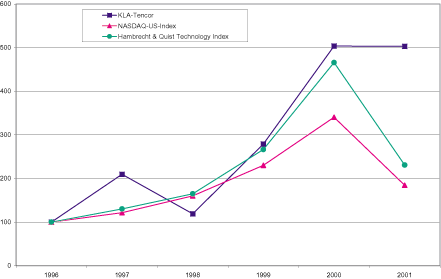Kenneth Levy is a co-founder of KLA
Instruments Corporation and since July 1, 1999 has been Chairman of the Board and a
Director of KLA-Tencor. From July 1998 until June 30, 1999, he was the Chief Executive
Officer and a Director. From April 30, 1997 until June 30, 1998 he was Chairman of the
Board. From 1975 until April 30, 1997 he was Chairman of the Board and Chief Executive
Officer of KLA Instruments Corporation. He currently serves on the boards of directors of
Ultratech Stepper, Inc., SpeedFam-IPEC, Inc. and is a Director Emeritus of SEMI, an
industry trade association.
Kenneth L. Schroeder has been
President, Chief Executive Officer and a Director of KLA-Tencor since July 1, 1999. From
November 1991 until June 30, 1999, he was President and Chief Operating Officer and a
Director. He currently serves on the board of directors of SEMI, an industry trade
association.
Edward W. Barnholt has been a
Director of the Company since 1995. Since May 1999, Mr. Barnholt has been President,
Chief Executive Officer and a director of Agilent Technologies, Inc. Mr. Barnholt was the
Executive Vice President and General Manager of the Test and Measurement Organization of
Hewlett-Packard Company from November 1996 to February 1999. He was elected a Senior Vice
President of Hewlett-Packard in 1993 and an Executive Vice President in 1996. From
December 1988 until 1990 he was General Manager of the Electronic Instrument Group of
Hewlett-Packard. In July 1988 he was elected Vice President of Hewlett-Packard. Mr.
Barnholt joined Hewlett-Packard in December 1966. He serves on the boards of directors of
Agilent Technologies, Inc. and the Tech Museum of Innovation.
H. Raymond Bingham has been a
Director of KLA-Tencor since August 2000. He has been the President and Chief Executive
Officer of Cadence Design Systems, Inc. since May 1999. Prior to this position, he served
as Executive Vice President and Chief Financial Officer of Cadence Design Systems, Inc.
from April 1993 to April 1999. Prior to joining Cadence Design Systems, Inc., Mr. Bingham
was Executive Vice President and Chief Financial Officer of Red Lion Hotels. He is the
chairman of the board of Electronic Design Automation Consortium and also serves on the
boards of directors of Cadence Design Systems, Inc., Legato Systems, Inc., and Onyx
Software Corporation.
Robert T. Bond has been a Director
of KLA-Tencor since August 2000. Mr. Bond has been a private investor since February
1998. From April 1996 to January 1998, Mr. Bond served as Chief Operating Officer of
Rational Software Corporation. Prior to that, he held various executive positions at
Rational Software Corporation. Mr. Bond was employed by Hewlett-Packard Company from 1967
to 1983 and held various management positions during his tenure there.
Richard J. Elkus, Jr. has been a
Director of KLA-Tencor since April 1997. He was Executive Vice President and Vice
Chairman of the board of directors of Tencor Instruments from February 1994 until April
1997. He is the Chairman of the Board and a director of Voyan Technology. He currently
serves on the boards of directors of SOPRA, Lam Research Corporation, and Virage Logic.
Dean O. Morton has been a Director
of KLA-Tencor since April 1997. From June 1993 until April 1997 he was a director of
Tencor Instruments. In October 1992 Mr. Morton retired as Executive Vice President, Chief
Operating Officer and a director of Hewlett-Packard Company. Mr. Morton held various
positions at Hewlett-Packard Company from 1960 until his retirement. Mr. Morton currently
serves on the boards of directors of The Clorox Company, BEA Systems Inc., Cepheid, and
Pharsight Corporation. Mr. Morton is also a trustee of the Metropolitan Series Fund and
State Street Research Funds Group and Portfolios, Inc.
Jon D. Tompkins was Chairman of the
Board from July 1998 to June 1999, when he retired his position as Chairman of the Board.
Mr. Tompkins has continued to serve as a Director. From May 1997 until July 1998 he was
Chief Executive Officer and a Director of KLA-Tencor. From April 1991 until April 1997 he
was President and Chief Executive Officer of Tencor Instruments prior to its merger with
KLA Instruments Corporation. He was a director of Tencor Instruments from 1991 until
April 1997 and was appointed Chairman of the Board of Directors of Tencor Instruments in
5
|


